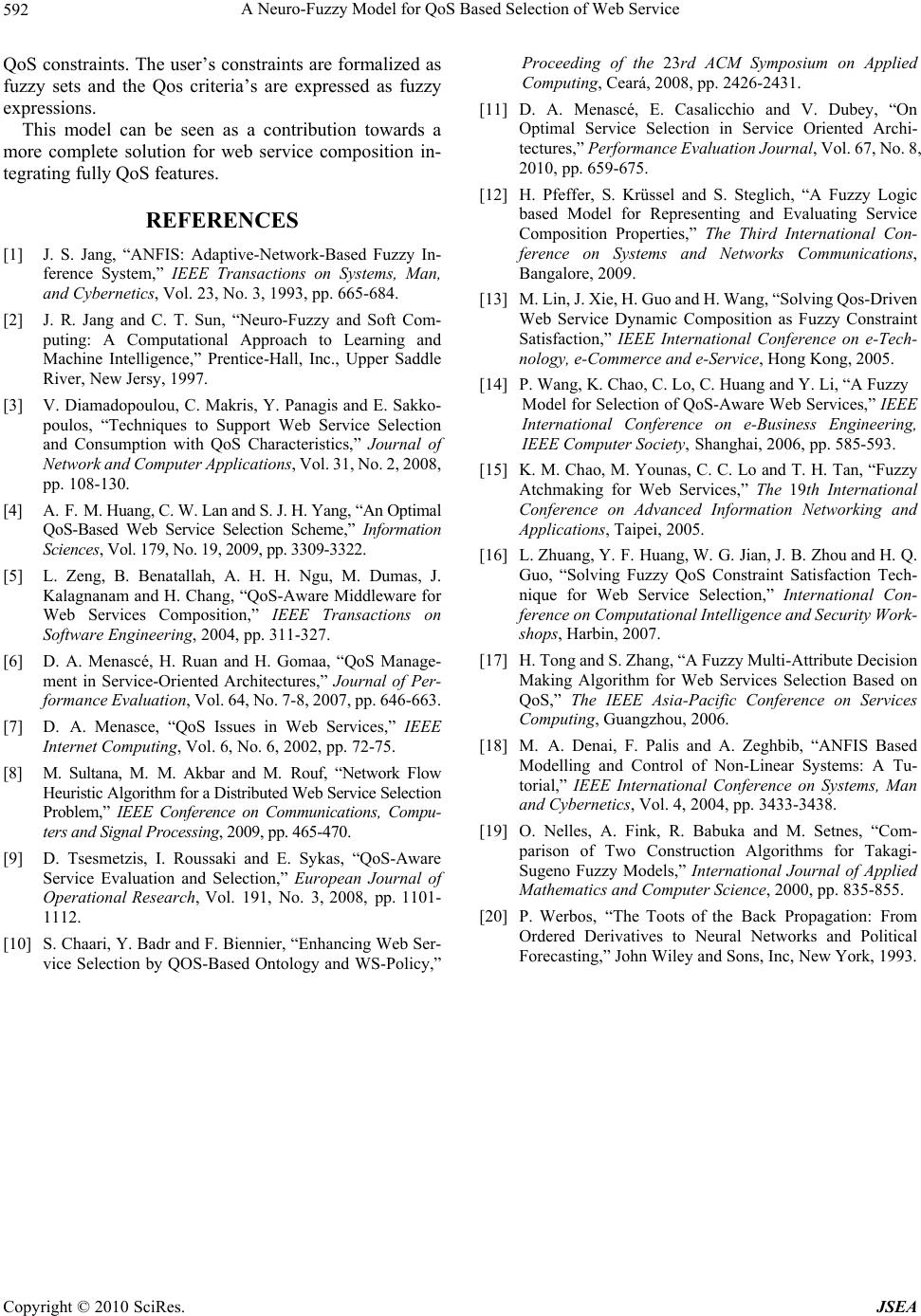
A Neuro-Fuzzy Model for QoS Based Selection of Web Service
Copyright © 2010 SciRes. JSEA
592
QoS constraints. The user’s constraints are formalized as
fuzzy sets and the Qos criteria’s are expressed as fuzzy
expressions.
This model can be seen as a contribution towards a
more complete solution for web service composition in-
tegrating fully QoS features.
REFERENCES
[1] J. S. Jang, “ANFIS: Adaptive-Network-Based Fuzzy In-
ference System,” IEEE Transactions on Systems, Man,
and Cybernetics, Vol. 23, No. 3, 1993, pp. 665-684.
[2] J. R. Jang and C. T. Sun, “Neuro-Fuzzy and Soft Com-
puting: A Computational Approach to Learning and
Machine Intelligence,” Prentice-Hall, Inc., Upper Saddle
River, New Jersy, 1997.
[3] V. Diamadopoulou, C. Makris, Y. Panagis and E. Sakko-
poulos, “Techniques to Support Web Service Selection
and Consumption with QoS Characteristics,” Journal of
Network and Computer Applications, Vol. 31, No. 2, 2008,
pp. 108-130.
[4] A. F. M. Huang, C. W. Lan and S. J. H. Yang, “An Optimal
QoS-Based Web Service Selection Scheme,” Information
Sciences, Vol. 179, No. 19, 2009, pp. 3309-3322.
[5] L. Zeng, B. Benatallah, A. H. H. Ngu, M. Dumas, J.
Kalagnanam and H. Chang, “QoS-Aware Middleware for
Web Services Composition,” IEEE Transactions on
Software Engineering, 2004, pp. 311-327.
[6] D. A. Menascé, H. Ruan and H. Gomaa, “QoS Manage-
ment in Service-Oriented Architectures,” Journal of Per-
formance Evaluation, Vol. 64, No. 7-8, 2007, pp. 646-663.
[7] D. A. Menasce, “QoS Issues in Web Services,” IEEE
Internet Computing, Vol. 6, No. 6, 2002, pp. 72-75.
[8] M. Sultana, M. M. Akbar and M. Rouf, “Network Flow
Heuristic Algorithm for a Distributed Web Service Selection
Problem,” IEEE Conference on Communications, Compu-
ters and Signal Processing, 2009, pp. 465-470.
[9] D. Tsesmetzis, I. Roussaki and E. Sykas, “QoS-Aware
Service Evaluation and Selection,” European Journal of
Operational Research, Vol. 191, No. 3, 2008, pp. 1101-
1112.
[10] S. Chaari, Y. Badr and F. Biennier, “Enhancing Web Ser-
vice Selection by QOS-Based Ontology and WS-Policy,”
Proceeding of the 23rd ACM Symposium on Applied
Computing, Ceará, 2008, pp. 2426-2431.
[11] D. A. Menascé, E. Casalicchio and V. Dubey, “On
Optimal Service Selection in Service Oriented Archi-
tectures,” Performance Evaluation Journal, Vol. 67, No. 8,
2010, pp. 659-675.
[12] H. Pfeffer, S. Krüssel and S. Steglich, “A Fuzzy Logic
based Model for Representing and Evaluating Service
Composition Properties,” The Third International Con-
ference on Systems and Networks Communications,
Bangalore, 2009.
[13] M. Lin, J. Xie, H. Guo and H. Wang, “Solving Qos-Driven
Web Service Dynamic Composition as Fuzzy Constraint
Satisfaction,” IEEE International Conference on e-Tech-
nology, e-Commerce and e-Service, Hong Kong, 2005.
[14] P. Wang, K. Chao, C. Lo, C. Huang and Y. Li, “A Fuzzy
Model for Selection of QoS-Aware Web Services,” IEEE
International Conference on e-Business Engineering,
IEEE Computer Society, Shanghai, 2006, pp. 585-593.
[15] K. M. Chao, M. Younas, C. C. Lo and T. H. Tan, “Fuzzy
Atchmaking for Web Services,” The 19th International
Conference on Advanced Information Networking and
Applications, Taipei, 2005.
[16] L. Zhuang, Y. F. Huang, W. G. Jian, J. B. Zhou and H. Q.
Guo, “Solving Fuzzy QoS Constraint Satisfaction Tech-
nique for Web Service Selection,” International Con-
ference on Computational Intelligence and Security Work-
shops, Harbin, 2007.
[17] H. Tong and S. Zhang, “A Fuzzy Multi-Attribute Decision
Making Algorithm for Web Services Selection Based on
QoS,” The IEEE Asia-Pacific Conference on Services
Computing, Guangzhou, 2006.
[18] M. A. Denai, F. Palis and A. Zeghbib, “ANFIS Based
Modelling and Control of Non-Linear Systems: A Tu-
torial,” IEEE International Conference on Systems, Man
and Cybernetics, Vol. 4, 2004, pp. 3433-3438.
[19] O. Nelles, A. Fink, R. Babuka and M. Setnes, “Com-
parison of Two Construction Algorithms for Takagi-
Sugeno Fuzzy Models,” International Journal of Applied
Mathematics and Computer Science, 2000, pp. 835-855.
[20] P. Werbos, “The Toots of the Back Propagation: From
Ordered Derivatives to Neural Networks and Political
Forecasting,” John Wiley and Sons, Inc, New York, 1993.